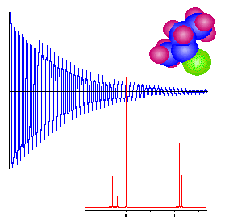Liquid Nuclear Magnetic Resonance Spectrometer

Nuclear Magnetic Resonance (NMR) spectrometry is the spectroscopic method based on the principle that a spiny nucleus held in a magnetic field resonates with a radio wave photon at the appropriate frequency. By using NMR, information can be obtained about the structure of the compound, its bonding properties, its molecular formula and weight, its molecular movements, and the structural arrangement of polymers.
Basically, we have two NMR devices in the NMR section of the METU Central laboratory. These are Bruker AVANCE's 300 MHz (~7 Tesla) solid and liquid spectrometers. Our liquid NMR spectrometer is high resolution and our solid NMR spectrometer is one of the first devices to perform 'solid NMR' analysis in Turkey today. The advantage of solid NMR comes from the ability to analyze the chemical environment of samples without dissolving them in any solution.
In our laboratory, it may be possible to use MAS (magic angle spinning) and CP (cross polarization) methods for examining solid samples. In short, the MAS method is a 'magic rotation' method applied to the magnetic field so that solid NMR spectra can be more specific. On the other hand, CP is the enhancement of the magnetic resonance signal of the 13C core with the cross polarization method. Unlike liquid NMR, solid NMR can analyze organic crystalline compounds, catalysts, zeolites, amorphous compounds, liquid crystals, polymers and biopolymers.
Information that can be obtained by NMR analysis:
- The nature of the compound.
- Structure and attachment.
- Composition of mixture components.
- Atomic composition.
- Molecular weight.
- Molecule formula.
- Polymer composition.
- Polymer layout.
- Molecular motion.
- Intermolecular exchange process .
- Intramolecular exchange process.
High Resolution Digital 300 MHz NMR Spectrometer
Bruker Biospin
Probe: 5 mm BBO 1H, 13C, 31P, 19F
Experiments: 1D: 1H, 13C, 31P, 19F nuclei, dept-45, dept-90, dept-135.
Sample Requirements: Pure samples must be supplied with indication of solvent. For 13C, minimum 40 - 50 mg of sample, for 1H, minimum 10-20 mg of sample is required.
Deuterium lock solvents available are: Chloroform-D1, Dimethyl sulfoxide-D6, Deuterated water, Acetone-D6, Benzene-D6, Toluene, Pyridine, Dimethyl formamide, dichloromethane-D2.

Nuclear Magnetic Resonance (NMR) spectrometry is the spectroscopic method based on the principle that a spiny nucleus held in a magnetic field resonates with a radio wave photon at the appropriate frequency. By using NMR, information can be obtained about the structure of the compound, its bonding properties, its molecular formula and weight, its molecular movements, and the structural arrangement of polymers.
Basically, we have two NMR devices in the NMR section of the METU Central laboratory. These are Bruker AVANCE's 300 MHz (~7 Tesla) solid and liquid spectrometers. Our liquid NMR spectrometer is high resolution and our solid NMR spectrometer is one of the first devices to perform 'solid NMR' analysis in Turkey today. The advantage of solid NMR comes from the ability to analyze the chemical environment of samples without dissolving them in any solution.
In our laboratory, it may be possible to use MAS (magic angle spinning) and CP (cross polarization) methods for examining solid samples. In short, the MAS method is a 'magic rotation' method applied to the magnetic field so that solid NMR spectra can be more specific. On the other hand, CP is the enhancement of the magnetic resonance signal of the 13C core with the cross polarization method. Unlike liquid NMR, solid NMR can analyze organic crystalline compounds, catalysts, zeolites, amorphous compounds, liquid crystals, polymers and biopolymers.
Information that can be obtained by NMR analysis:
- The nature of the compound.
- Structure and attachment.
- Composition of mixture components.
- Atomic composition.
- Molecular weight.
- Molecule formula.
- Polymer composition.
- Polymer layout.
- Molecular motion.
- Intermolecular exchange process .
- Intramolecular exchange process.
High Resolution Digital 300 MHz NMR Spectrometer
Bruker Biospin
Probe: 5 mm BBO 1H, 13C, 31P, 19F
Experiments: 1D: 1H, 13C, 31P, 19F nuclei, dept-45, dept-90, dept-135.
Sample Requirements: Pure samples must be supplied with indication of solvent. For 13C, minimum 40 - 50 mg of sample, for 1H, minimum 10-20 mg of sample is required.
Deuterium lock solvents available are: Chloroform-D1, Dimethyl sulfoxide-D6, Deuterated water, Acetone-D6, Benzene-D6, Toluene, Pyridine, Dimethyl formamide, dichloromethane-D2.
